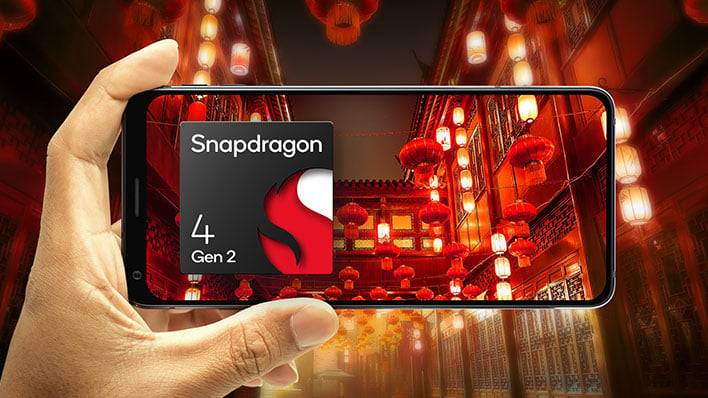Qualcomm Snapdragon 4 Gen 2 Brings Elevated 5G Connectivity, Multi-Day Performance

It's been less than a year since Qualcomm unveiled its Snapdragon 4 Gen 1 chipset for entry-level smartphones and there's already a followup act. Meet the Snapdragon 4 Gen 2, another SoC that takes aim at the value tier with some key upgrades over its predecessor, including on the manufacturing side—this is Qualcomm's first 4-series chipset to be built on a 4-nanometer node.
What does that mean for consumers? Node shrinks typically bring about better efficiency and performance improvements, By extension, efficiency gains in the realm of mobile translate into the potential for better battery life, with Qualcomm claiming its Snapdragon 4 Gen 2 will help devices "stay powered for longer, then refuel in a flash with Qualcomm Quick Charge 4+ technology." More specifically, Qualcomm claims its Quick Charge 4+ technology is capable of refilling up to 50 percent of a battery in just 15 minutes.
Circling back to raw performance, the Snapdragon 4 Gen 2 once again features a Kryo CPU (the same architecture powering its flagship Snapdragon 8 Gen 2) consisting of a 2+6 CPU core configuration like its predecessor, but cranks up the clock speeds. The two Cortex-A78 performance cores now go up to 2.2GHz (up from 2GHz), while the six Cortex-A55 efficiency cores go up to 2GHz (up from 1.8GHz). So we're looking at max clock speed gains of 200MHz across the board.
According to Qualcomm, those gains result in up to 10 percent better performance. As for graphics, Qualcomm is less forthcoming and simply states that its Snapdragon 4 Gen 2 is running an Adreno GPU.
Outside of compute and possible graphics gains, Qualcomm is also touting support for faster memory to the tune of LPDDR5x up to 3,200MHz (it also supports for LPDDR4X up to 2,133MHz like its predecessor), and speedier storage thanks a controller upgrade to UFS 3.1 (versus UFS 2.2).
Interestingly, the Snapdragon 4 Gen 2 supports just two camera modules instead of three like its predecessor. However, Qualcomm is also flexing new AI enhancements to help with low-light photography and multi-camera temporal filtering (MCTF) support, so we'll have to wait and see how that pans out.
Finally, the Snapdragon 4 Gen 2 sports an integrated Snapdragon X61 5G modem with support for the 3rd Generation Partnership Project (3GPP) Release 16 specification. This doesn't do anything for bandwidth compared to the X51 in the Snapdragon 4 Gen 1 (up to 2.5Gbps for downloads and 900Mbps for uploads), but users should see better coverage from the upgrade, and help more users get connected globally.
Qualcomm says you can expect to see the first devices equipped with its Snapdragon 4 Gen 2 chipset in the second half of this year, including ones from Redmi and Vivo.


